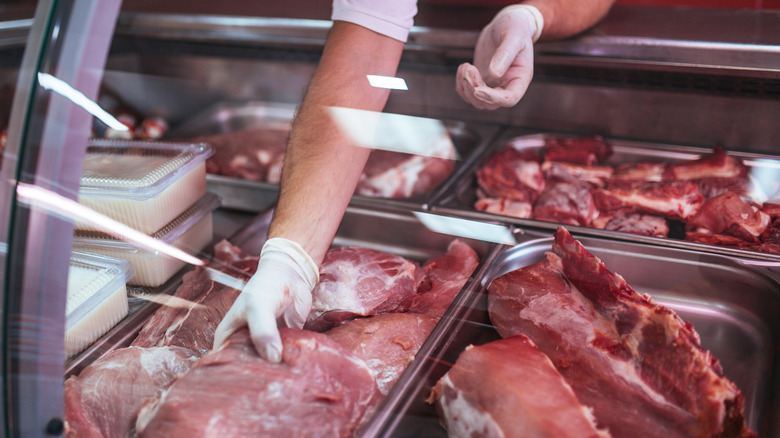Which Pork Cut Is The Fattiest?
It is becoming increasingly difficult to find a fattier cut of pork at the store, but whether that is a good thing is up for debate. For decades, people were taught that fat equals bad, and that eating too much of it was detrimental to heart health. To compete in a market that demands lean meat, pork breeders adapted and increasingly bred pigs that were leaner and leaner. Aside from the fact that the fat isn't as significant a nutritional problem as it was made out to be, fat tastes good. Like the marbling on an expensive piece of steak, fat carries flavor and makes meat more tender and juicy. While pork chops now have nary a streak of fat through them and pork loin is mostly dry and tasteless, some parts of the pig resisted the fat-free diet imposed on them. If you want a fattier cut of pork, the pork belly is the way to go.
Pork belly is the fattiest cut on a pig and a source of incredible flavor. It is also pretty self-descriptive, pulled from the bottom of the pig, sometimes called the side. Coming from around the stomach, this area naturally has the highest proportion of fat to meat, with the average cut containing a whopping 48% fat. For meat lovers, that fat isn't a curse; it's a blessing, making pork belly incredibly rich and versatile. Plus, it is simply delicious.
The multi-purpose and delicious pork belly
For quite some time, pork belly has been a trendy item on restaurant menus, as chefs have rediscovered how wonderful (and affordable) it can be. For folks in the U.S., the most familiar form of pork belly is American-style "streaky" bacon. These cuts of bacon are taken from pork belly and smoked. Other popular bacon cuts, like pancetta, also come from the pork belly, owing much of their beloved flavor to all that fat.
Outside of bacon, you will most likely find pork shoulder in larger slabs at the grocery store. These can be cooked whole as roasts, with Italian porchetta being a popular recipe, or cut into slices for a quicker meal. With all the fat and connective tissue, larger pieces of pork belly necessitate longer, low and slow cooking styles such as roasting or braising. Be aware that the biggest mistake you can make with braised or roasted pork belly is not cooking it long enough. All that fat takes time to render and will need several hours of cooking at a minimum.
Smaller strips and chunks of pork belly can be seared or pan-fried. Thin strips can be cooked like bacon, while thicker slabs will require more time to render out the fat. When pan-frying, it helps to trim thicker layers of fat from the outside of the slices so they cook faster. Don't worry, though; there will still be more than enough fat to make them delicious.

